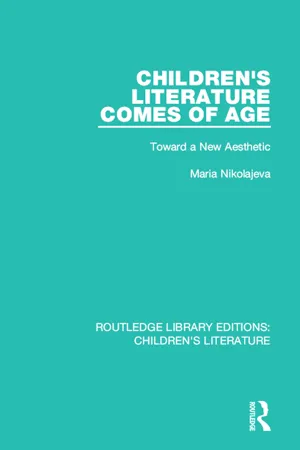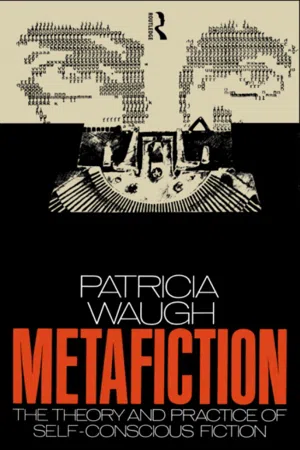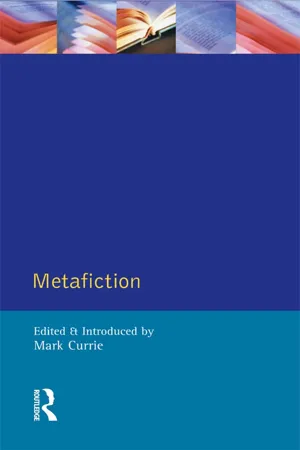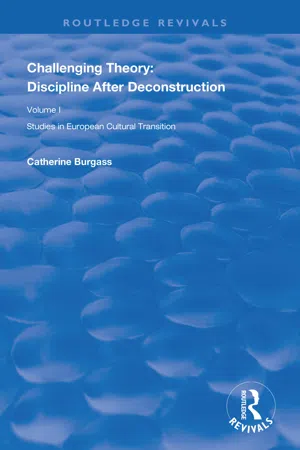Metafiction
Metafiction is a literary technique that draws attention to the artificiality of the narrative, often by breaking the fourth wall or self-consciously referencing its own status as a work of fiction. It blurs the line between fiction and reality, inviting readers to consider the nature of storytelling and the role of the author. Metafiction can be found in various literary genres and styles.
8 Key excerpts on "Metafiction"
- eBook - ePub
Children's Literature Comes of Age
Toward a New Aesthetic
- Maria Nikolajeva(Author)
- 2015(Publication Date)
- Routledge(Publisher)
...Sometimes we discover such statements in literary analyses which are reminiscent of medical journals in that they treat figures in novels as if they were indeed patients (“Rusky goes through a psychic crisis with the following symptoms …”). Many a critic today seriously questions reading fiction mimetically, as if there were a reality behind the words. In mimetic reading the first-person narrator in a novel is identified with the writer. Realism as a literary device is confused with credibility or verisimilitude. However, unlike documentary or journalism, fiction is not a direct reflection of reality but an artistic transformation of it. As various reception studies have pointed out, in any work of art there is a relationship between the author, the text and the reader. The notions of the implied writer and the implied reader, the narrator and the narratee are of general significance for our understanding of the nature of children’s literature. More and more children’s books consciously pose questions about the relationship between the writer, his creations and his readers. Such texts have been named Metafiction, books about books and the writing of books, books which somehow explain themselves, investigating the essence of writing by describing the creative process itself. The diversity of Metafictional levels we can observe in literature today is a feature of its postmodern phase, although it can be found in texts from much earlier periods. Still, it is only recently that literary critics have both become aware of this fascinating device and started examining it. A study by Patricia Waugh, Metafiction. The Theory and Practice of Self-conscious Fiction, is wholly devoted to this subject. 1 Patricia Waugh defines Metafiction as “fictional writing which selfconsciously and systematically draws attention to its status as an artifact in order to pose questions about the relationship between fiction and reality” (p. 2)...
- eBook - ePub
Metafiction
The Theory and Practice of Self-Conscious Fiction
- Patricia Waugh(Author)
- 2002(Publication Date)
- Routledge(Publisher)
...Very often realistic conventions supply the ‘control’ in Metafictional texts, the norm or background against which the experimental strategies can foreground themselves. More obviously, of course, this allows for a stable level of readerly familiarity, without which the ensuing dislocations might be either totally meaningless or so outside the normal modes of literary or non-literary communication that they cannot be committed to memory (the problem, already discussed, of much contemporary ‘aleatory’ writing). Metafiction, then, does not abandon ‘the real world’ for the narcissistic pleasures of the imagination. What it does is to re-examine the conventions of realism in order to discover – through its own self-reflection – a fictional form that is culturally relevant and comprehensible to contemporary readers. In showing us how literary fiction creates its imaginary worlds, Metafiction helps us to understand how the reality we live day by day is similarly constructed, similarly ‘written’. ‘Metafiction’ is thus an elastic term which covers a wide range of fictions. There are those novels at one end of the spectrum which take fictionality as a theme to be explored (and in this sense would include the ‘self-begetting novel’), as in the work of Iris Murdoch or Jerzy Kosinski, whose formal self-consciousness is limited. At the centre of this spectrum are those texts that manifest the symptoms of formal and ontological insecurity but allow their deconstructions to be finally recontextualized or ‘naturalized’ and given a total interpretation (which constitute, therefore, a ‘new realism’), as in the work of John Fowles or E. L. Doctorow...
- eBook - ePub
- Mark Currie(Author)
- 2014(Publication Date)
- Routledge(Publisher)
...There is also something about postmodern fiction, the deep involvement with its own past, the constant dialogue with its own conventions, which projects any self-analysis backwards in time. Novels which reflect upon themselves in the postmodern age act in a sense as commentaries on their antecedents. ‘Self-consciousness’ is neither new nor meaningfully ‘self consciousness, since the Metafiction refers to fictions other than itself, in its own history. The relationship between a critical term and its literary object becomes profoundly confused because the literary object itself performs a critical function. The definition of ‘Metafiction’ as fictional self-consciousness does not acknowledge this complexity, and my continued use of the notion of self-consciousness here carries such problems within it. This volume begins from the definition of Metafiction as a borderline discourse, as a kind of writing which places itself on the border between fiction and criticism, and which takes that border as its subject. Far from being some marginal no-man's-land, this definition gives Metafiction a central importance in the projects of literary modernity, postmodernity and theory which have taken this borderline as a primary source of energy. The borderline between fiction and criticism has been a point of convergence where fiction and criticism have assimilated each other's insights, producing a self-conscious energy on both sides. For criticism this has meant an affirmation of literariness in its own language, an increased awareness of the extent to which critical insights are formulated within fiction, and a tendency towards immanence of critical approach which questions the ability of critical language to refer objectively and authoritatively to the literary text...
- eBook - ePub
- Jerome De Groot(Author)
- 2009(Publication Date)
- Routledge(Publisher)
...Metafictional writing, for Waugh, is historically particular, and begins in the mid-1960s: ‘Contemporary Metafictional writing is both a response and a contribution to an even more thoroughgoing sense that reality or history are provisional; no longer a world of eternal verities but a series of constructions, artifices, impermanent structures’ (Waugh 1984: 7). In order to express this, novelists began to turn away from traditional methods that ‘correspond to this ordered reality’, in particular those relating to chronology, the omniscient narrator and questions of narrative linearity (Waugh 1984: 7). Metafiction is a type of writing which demonstrates the play of the linguistic and representational system and the loss of assurance in articulation. It effectively challenges the realist mode: Metafictional deconstruction has not only provided novelists and their readers with a better understanding of the fundamental structures of narrative; it has also offered extremely accurate models for understanding the contemporary experience of the world as a construction, an artifice, a web of interdependent semiotic systems. (Waugh 1984: 9) Waugh's Metafiction draws upon the literary and cultural theories of Jacques Derrida, Michel Foucault and Roland Barthes in particular, post-structuralist and deconstructionist critics who suggest that language is indeterminate and therefore meaning is constantly deferred. She points to Alain Robbe-Grillet, John Fowles and B. S. Johnson among others as examples of novelists who have subverted and attacked mainstream methods in order to experiment with narratives and forms that consciously interrogate the action of reading and writing...
- eBook - ePub
Challenging Theory: Discipline After Deconstruction
Studies in European Cultural Transition , Volume One
- Catherine Burgass, Martin Stannard, Gerg Walker, Martin Stannard, Gerg Walker(Authors)
- 2019(Publication Date)
- Routledge(Publisher)
...In fact, Aristotle presents Metafiction and mimesis as irreconcilable and lauds Homer for his refusal to intrude upon the narrative: ‘The poet should say very little in his own character, as he is no imitator when doing that’ {1460 a }. 9 For Aristotle, both narrative and drama are the means of representation: ‘one may either speak at one moment in narrative and at another in an assumed character, as Homer does’, but ‘The objects the imitator represents are actions’ {1448 a }, and these objects should be interpreted as the actions of the characters rather than those of the author or reader. Hutcheon promotes too wide a definition of Metafiction, incorporating both ‘auto-representation’ (the linguistic self-consciousness of the nouveau roman, Ada or Finnegan’s Wake), and fictive self-consciousness. This is to stretch the term too far; where Finnegan’s Wake ignores the world in favour of the word, the modernist foregrounding of language cannot be equated with the postmodernist foregrounding of fiction since it has a different effect and is born of different intentions. Metafiction deliberately foregrounds and explicitly thematizes the text’s fictional status and the reading experience; modernist or postmodernist word-play may defamiliarize, but is not generally designed to alienate in this pseudo-Brechtian manner. The literary forms favoured by poststructuralist theorists include the linguistic self-consciousness of modernist texts and the literary self-consciousness of postmodernism, both of which apparently subvert the conventions of ‘classic’ realism...
- eBook - ePub
- Monika Fludernik(Author)
- 2009(Publication Date)
- Routledge(Publisher)
...The first two of these are traditionally put together under the heading of ‘fictionality’ whereas the third, labelled ‘fictivity’, is mainly encountered in philosophy and mathematics and hardly features in literary theory at all. One can also note that when the concept of fictionality is used, it generally refers to fictum, and that truth in the historical or practical sense of the word can only be generated in context by comparison with other information. The fact that objects, people and places actually exist cannot be adduced from the text alone but must be supported by evidence from the context and other sources of information. Metafiction and metanarration At this point it might be helpful to clarify two concepts that are often used in connection with postmodern texts and are frequently regarded as signs of anti-realism: metanarration and Metafiction. We should note, to begin with, that these terms are often treated as identical in meaning, particularly in the English-speaking world. Metanarrative narratorial comments are widely seen as evidence of fictionality and so they are often considered to be instances of Metafictionality. Such an equivalence cannot be taken for granted, however. On the contrary, metanarrative comments can considerably strengthen the illusionistic effect of a realistic narrative, as Ansgar Nünning has pointed out (Nünning 2004). Metanarrative narratorial comments are to be found in texts dating from long before the twentieth century; indeed, they already existed in the Middle Ages. In conversational narrative, the so-called abstract can be counted as a metanarrative comment on the part of the storyteller, for example: ‘Have I already told you about the time when the parrot came and perched on my head?’ Metanarrative statements fulfil a wide variety of functions, most of them hardly noticeable as the phrases are so short, like the verb ‘told’ in the example above...
- eBook - ePub
Narrative Form
Revised and Expanded Second Edition
- Suzanne Keen(Author)
- 2015(Publication Date)
- Palgrave Macmillan(Publisher)
...The manipulation of narrative level, discussed in the previous chapter, can account for the presence of stories within stories through the presence of more than one teller who narrates an additional layer of story. Another set of alternatives, represented by the world-making of fantasy fiction, dream visions, postmodern historiographic Metafictions, and other varieties of romance, occurs when narrative deploys fictional worlds that contain other worlds within them. 7 When a single narrator carries the reader over the ontological boundaries marking the differences between these story realms, as in Neil Gaiman’s Neverwhere (1996), then a complication of fictional worlds which cannot be explained by the language for narrative levels has occurred. Some formal issues that have often attracted the attention of critics interested in fictionality and fictional worlds include the examination of front matter and what Genette calls paratexts ; the role of naming in establishing the existence of characters within fictional worlds, or in characterizing the worlds themselves; the use of settings and representations of places and spaces in fictional worlds; and the relationship between settings and plot functions, following Vladimir Propp on plot functions and Mikhail Bakhtin on the chronotope. Franco Moretti has called for the practice of ‘distant reading’ of fictional worlds, using methods of analysis that result in the creation of maps, trees, and graphs of fictional worlds and the texts in which they are contained. Moretti is most interested in the mainstream realistic texts of the European tradition, although his call to use maps as a method of reaching new kinds of literary understandings can be extended well beyond that field...
- eBook - ePub
Fantasy and Mimesis (Routledge Revivals)
Responses to Reality in Western Literature
- Kathryn Hume(Author)
- 2014(Publication Date)
- Routledge(Publisher)
...(3) Writers recognize that they lack answers to our problems, but they go over and over the questions, checking out possibilities, looking at our fictional tools and techniques. Metafiction by Barth, Borges, Sorrentino, and Barthelme not only help us understand literature as criticism, it makes the argument that we can and should enjoy this state of affairs rather than long for a new naivete. Borges, for instance, half-persuades us in “Pierre Menard” that the ironic twentieth-century text of the Quixote is richer and more profound than the original. (4) Some writers are trying to assert a new kind of meaning, a new sense of conviction and involvement; a new relationship to the cosmos; sometimes even a new mythology. In this group would go some works by writers called “post-modernist”, although that slippery term is also applied simply to Metafiction. John Barth, in an essay on post-modernism, suggests Gabriel Garcia Márquez’ One Hundred Years of Solitude and Calvino’s Cosmicomics as post-modernist fictions. I concur enthusiastically with Cosmicomics, and would suggest adding some of Doris Lessing’s space fictions and Pynchon’s Gravity’s Rainbow. Since all of the authors of these various kinds of contemporary fiction have somehow escaped the silence implied by the void, and since all find some meaning in the act of writing and even in the action of their characters, it is worth looking at their solutions. No obvious new genre or even single kind of answer has yet coalesced, except insofar as the quest itself is a kind of function. From the various schools of literary endeavor, however, we can see what kinds of meaning are being sought, and are being upheld as still valid...







